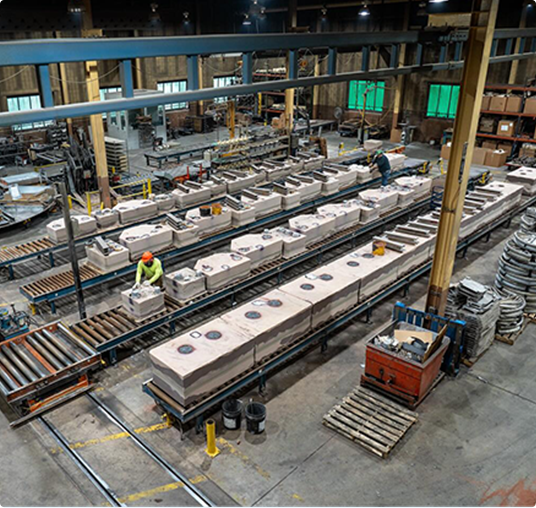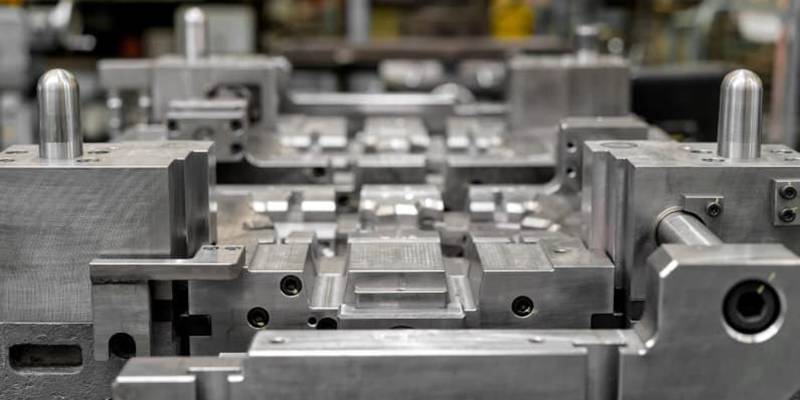Aluminum Castings and sustainability: Why they matter
The Role of Aluminum Casting in Progressing Sustainable Production Practices
Aluminum casting works as an important component in advertising lasting production methods. Its capability to produce high-grade parts with a minimized environmental impact is remarkable. The procedure not just supports power performance however additionally significantly boosts recyclability. However, obstacles remain in completely understanding its potential. Discovering the innovations in aluminum casting innovation can reveal services that line up making with sustainability goals. The implications of these improvements deserve considering.
Understanding Aluminum Casting and Its Process
Aluminum casting has actually been a basic procedure in making for years, its significance continues to grow in various industries due to its flexibility and effectiveness. This process includes pouring molten aluminum into molds to produce complex shapes and elements, making it optimal for generating light-weight yet sturdy items. The aluminum casting procedure can be classified right into a number of techniques, including sand casting, die casting, and investment casting, each offering distinct advantages suited to particular applications.
During the casting process, aluminum is warmed to its melting factor, permitting it to move conveniently right into molds that specify the last shape. When cooled, the aluminum strengthens, resulting in a solid and specific part. The capability to produce complex geometries with marginal waste emphasizes aluminum casting's function in modern production - Aluminum Castings. As markets seek innovative remedies, comprehending this process comes to be crucial for maximizing production and fulfilling the demands of an evolving market
Ecological Benefits of Aluminum Casting
As industries significantly prioritize sustainability, the ecological benefits of aluminum casting become a lot more pronounced. One substantial advantage is the product's recyclability; aluminum can be recycled repeatedly without weakening its top quality. This minimizes the amount of waste sent to garbage dumps and lessens the need for virgin materials, conserving natural deposits. Additionally, the aluminum casting procedure generates less greenhouse gas emissions compared to various other metal casting techniques, adding to lower total environmental influence.
Another advantage hinges on the lightweight nature of aluminum, which brings about fuel effectiveness in transport applications. By utilizing aluminum elements, manufacturers can minimize lorry weight, resulting in reduced gas consumption and discharges throughout procedure. Furthermore, innovations in aluminum casting technologies have brought about a decrease in contaminated materials manufacturing, boosting overall ecological security. Collectively, these aspects placement aluminum casting as a principal in promoting sustainable manufacturing practices and meeting environmental goals across different markets.
Energy Effectiveness in Aluminum Production
Power performance plays an essential role in aluminum manufacturing, significantly affecting general sustainability. By embracing cutting-edge casting strategies and incorporating renewable resource resources, suppliers can attain minimized power usage throughout the production process. This shift not just decreases functional expenses however also adds to an extra eco-friendly market.

Reduced Energy Usage
While the aluminum production sector has actually traditionally been energy-intensive, recent developments have considerably boosted power performance throughout the manufacturing procedure. Innovations in smelting technology and the adoption of high-efficiency furnaces have significantly decreased energy usage. These improvements allow producers to use less energy per unit of output, reducing greenhouse gas emissions and lowering operational costs. Additionally, the assimilation of eco-friendly power resources into production facilities further adds to lowered reliance on fossil gas, advertising sustainability. Applying innovative insulation materials and enhancing heat recovery systems additionally plays a crucial duty in optimizing power effectiveness. Consequently, the aluminum sector is making considerable strides toward reducing its total ecological footprint while fulfilling the boosting demand for lasting techniques in manufacturing.
Innovative Casting Strategies
Ingenious casting techniques are changing the aluminum manufacturing landscape, boosting both effectiveness and sustainability. Advanced methods such as die casting and financial investment casting reduce product waste and enhance dimensional accuracy, bring about decreased power usage throughout the manufacturing process. Techniques like fast solidification and semi-solid processing enable better control over metallurgical properties, leading to lightweight and high-strength elements. Additionally, the application of computer system simulations and automation in casting processes maximizes cycle times and decreases issue rates. These technologies not only enhance production however additionally contribute to the round economic situation by allowing the recycling of aluminum scrap right into top quality items. Consequently, the aluminum industry is positioned to fulfill growing demands while sticking to sustainable manufacturing methods.
Renewable Power Integration
A significant change towards sustainable power assimilation is reshaping energy effectiveness in aluminum production. This change involves using solar, wind, and hydropower resources to lower reliance on fossil fuels, substantially lowering carbon emissions. Facilities are progressively embracing energy-efficient modern technologies, such as advanced electrolytic processes, which optimize energy usage throughout aluminum manufacturing. By using renewable resource, manufacturers not only decrease operational expenses however likewise improve their sustainability accounts. Furthermore, clever grid modern technologies promote the smooth integration of renewable sources, permitting more stable power products. As the industry embraces these developments, the aluminum industry is positioned to lead in sustainable practices, showing a dedication to ecological stewardship while meeting enhancing global demand for lightweight, high-performance materials.
The Recyclability of Aluminum and Its Impact
Aluminum's recyclability provides significant benefits in lasting production, permitting unlimited recycling without loss of quality. This home not only reduces waste yet additionally improves energy performance throughout the recycling process. Because of this, the effect on both the environment and manufacturing expenses is extensive, making aluminum a popular product in eco-conscious markets.
Infinite Recycling Potential
Numerous products lose top quality with recycling procedures, aluminum stands out due to its infinite recyclability, which substantially contributes to lasting manufacturing techniques. This distinct particular enables aluminum to be reused consistently without weakening its buildings, making it a useful source in different sectors. The lifecycle of aluminum begins once more with each recycling effort, preserving raw materials and minimizing waste. This not just reduces the ecological impact however additionally fosters a circular economic situation where aluminum can be reused many times. The high need for recycled aluminum further highlights its relevance in sustainable manufacturing, as it improves source efficiency and promotes a green method to production. Inevitably, the infinite recycling capacity of aluminum plays a considerable duty ahead of time sustainable practices throughout sectors.

Energy Performance Advantages
Substantial energy financial savings are realized via the recycling of aluminum, highlighting its role in lasting production. Recycling aluminum calls for only 5% of the energy required to produce brand-new aluminum from basic materials. This considerable decrease in power usage converts into lower greenhouse gas exhausts, contributing to environmental sustainability. The power efficiency of aluminum recycling not just preserves resources however additionally reduces operational prices for manufacturers, making it an economically feasible alternative. Additionally, the process of reusing aluminum can be incorporated right into existing assembly line without considerable disturbance, boosting general effectiveness. As sectors increasingly prioritize sustainability, the recyclability of aluminum settings it as a principal ahead of time energy-efficient production practices, fostering a circular economic climate and advertising liable source administration.
Challenges Facing Aluminum Casting in Sustainable Practices
While the aluminum casting market has made strides towards sustainable methods, a number of difficulties stay that impede its development. One considerable problem is the high energy consumption connected with conventional casting methods, which frequently relies upon nonrenewable fuel sources. This dependence not only boosts operational prices but additionally adds to greenhouse gas exhausts. Furthermore, the reusing procedure for aluminum can be ineffective, leading to worldly loss and raised waste. An additional difficulty is the restricted availability of lasting basic materials, as sourcing recycled aluminum can be tough and expensive. Governing pressures and varying ecological requirements across areas complicate conformity efforts, making it challenging for business to adopt consistent sustainable practices. Ultimately, workforce training continues to be insufficient, with many staff members lacking the necessary abilities to implement cutting-edge, environment-friendly techniques in casting procedures. Resolving these challenges is crucial for the aluminum casting market to totally realize its capacity in lasting manufacturing.
Technologies in Aluminum Casting Technology
To get rid of the challenges dealt with in lasting techniques, the aluminum casting industry additional resources is experiencing a wave of navigate to this site innovations aimed at boosting efficiency and decreasing ecological influence. Advanced casting methods, such as 3D printing and die casting, are being embraced to decrease material waste and improve precision. These modern technologies make it possible for manufacturers to create complicated geometries with much less aluminum, therefore conserving resources.
Furthermore, the combination of reusing strategies, including closed-loop systems, helps with using scrap aluminum, substantially reducing energy usage contrasted to main aluminum manufacturing. Boosted mold and mildew layouts and coatings are also adding to sustainability by improving thermal efficiency and decreasing discharges during the casting process.
Furthermore, automation and wise manufacturing modern technologies are being applied to enhance manufacturing processes, resulting in reduced cycle energy and times use. Collectively, these developments represent a substantial shift in the direction of even more sustainable practices within the aluminum casting sector, aligning with more comprehensive ecological goals.
Future Prospects for Lasting Production With Aluminum Casting
As the demand for lasting manufacturing techniques heightens, the aluminum casting sector is poised to play a crucial role in forming a greener future. The sector is progressively taking on recycling processes that substantially minimize waste and energy usage, straightening with global sustainability objectives. Innovations such as low-energy casting methods and using recycled aluminum web link not just reduce carbon impacts yet also improve the total efficiency of production.

As sectors seek to adhere to more stringent environmental guidelines, the aluminum casting industry stands ready to supply lasting services, placing itself as a vital player in the shift in the direction of eco-friendly manufacturing methods in numerous sectors, including vehicle and aerospace.
Regularly Asked Questions
Exactly How Does Aluminum Casting Contrast to Various Other Steel Casting Methods?
Aluminum casting typically uses benefits such as reduced melting factors and superior recyclability compared to other metal casting techniques. Its light-weight nature and superb deterioration resistance further enhance its appeal in different manufacturing applications.
What Industries Benefit A Lot Of From Aluminum Casting?
Different sectors, consisting of auto, aerospace, and durable goods, substantially gain from aluminum casting - Aluminum Castings. This approach's light-weight, corrosion-resistant properties enhance product performance while permitting intricate layouts, making it an eye-catching alternative for suppliers looking for performance and advancement
Can Aluminum Casting Be Utilized for Complicated Styles?
Aluminum casting can efficiently accommodate complex layouts as a result of its adaptability and capability to develop intricate forms. This procedure allows producers to create light-weight, long lasting elements suitable for various applications throughout different industries, boosting advancement and effectiveness.
What Is the Lifespan of Aluminum Cast Products?
The life-span of aluminum actors products typically varies from a number of years to over a century, depending upon elements such as ecological problems, maintenance, and the details application. Toughness makes them suitable for numerous long-lasting uses.
Just How Does Aluminum Casting Impact Work Development in Production?
Aluminum casting significantly contributes to task creation in production by fostering knowledgeable labor chances, supporting local economic situations, and encouraging technical developments. This procedure not only improves production effectiveness yet likewise advertises workforce growth and training initiatives.